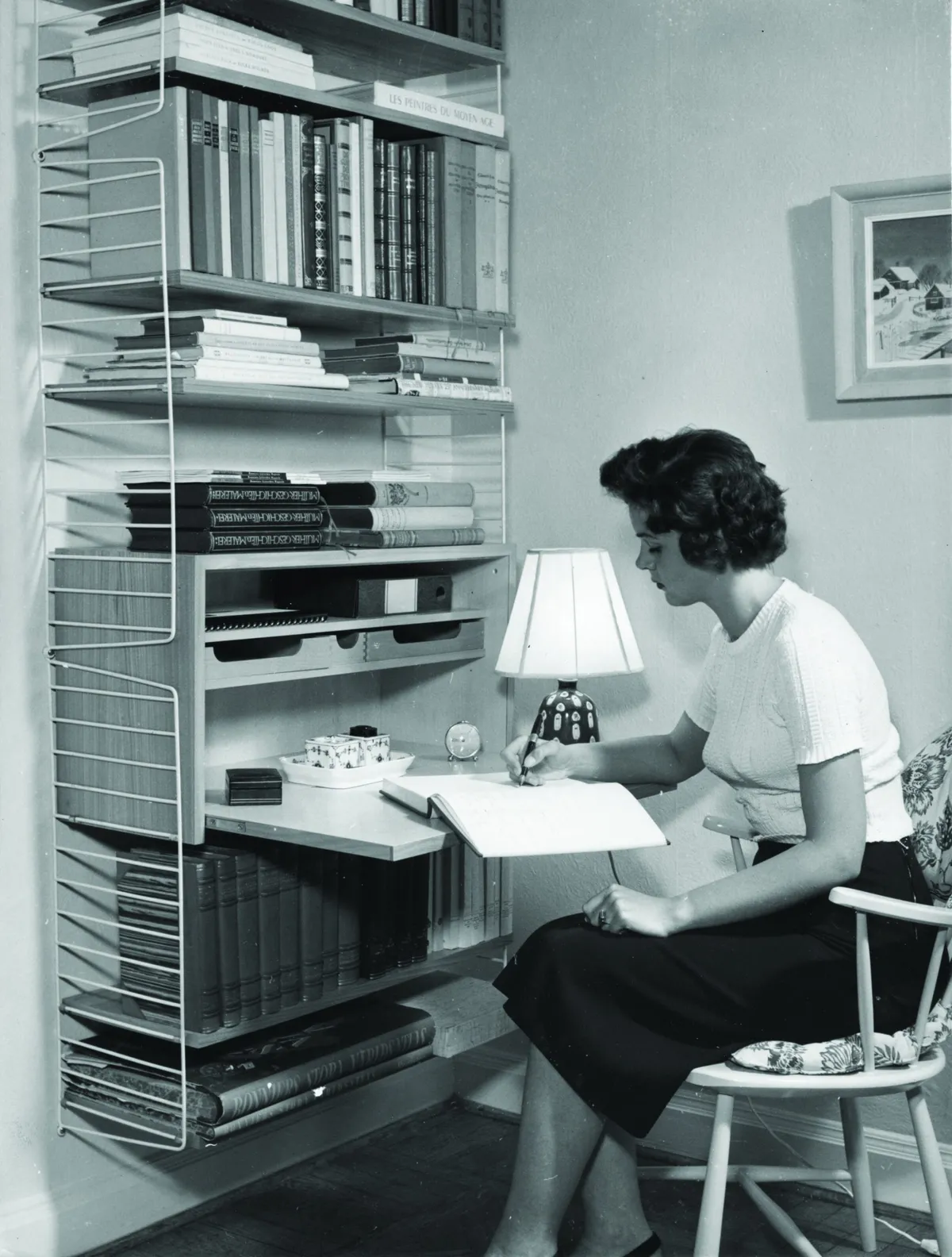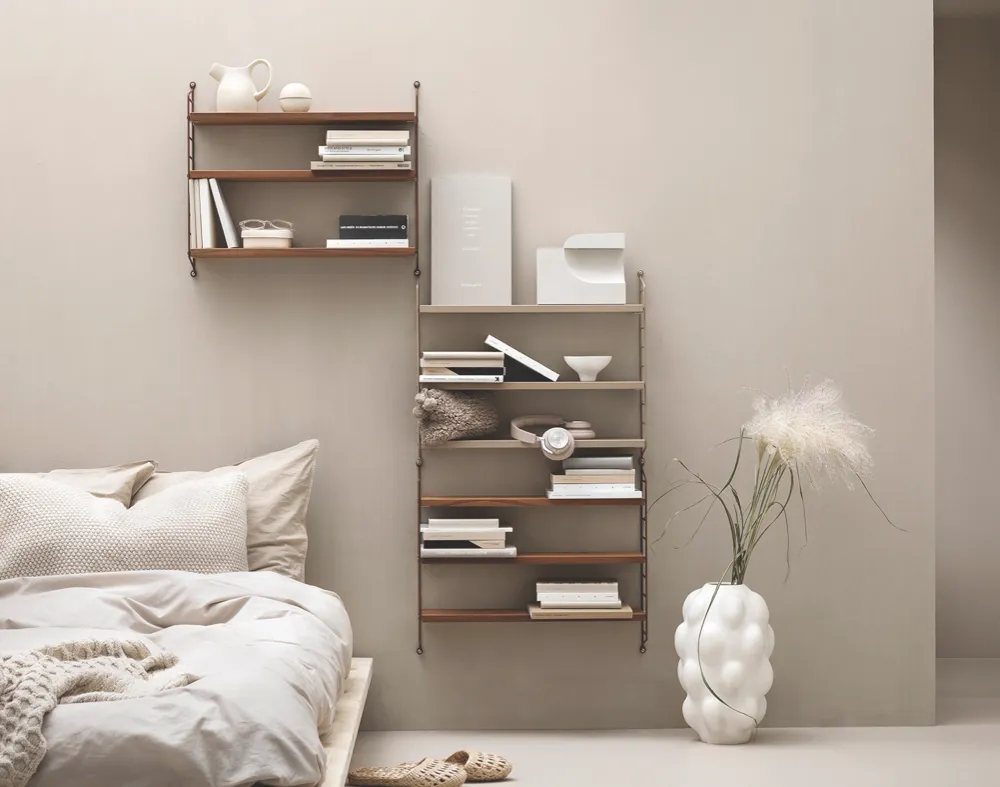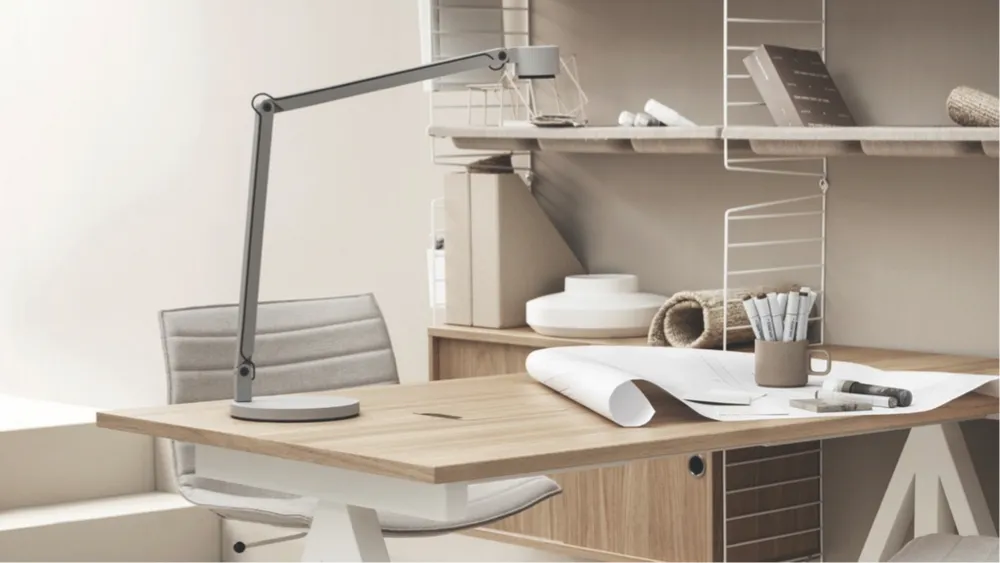Sweden, 1949. Publishing giant, Bonnier, rides the postwar reading boom by launching a book club, sending out new titles monthly. A problem arises: rich folk can build shelving, but to sustain sales they need a bookshelf for the people. After 192 architects proffer solutions, one entry stands out: light, airy, affordable, endlessly flexible and, packing down flat, ideal for shipping. The String Shelving System, one of the 20th century’s most influential furniture designs, is born.

Nils Strinning was in his late twenties when his wife, Kajsa, asked him to dry the dishes. ‘He thought towels were unclean,’ says String Furniture CEO, Peter Erlandsson, ‘so he made a metal dish rack dipped in rust-preventing plastic.’ Three years later, Bonnier’s competition launched and Nils remembered his dish rack. Turned vertically, its steel wires became ladders, perfect for holding shelving or cabinets, ripe for near-infinite configuration.
Manufacture began in 1950. Global success germinated in 1954, with gold at the Triennale di Milano, then flowered a year later at Sweden’s H55 exhibition – which, says Peter, was the event thatmade the rest of the world sit up and take notice of Scandinavian design. A global rise in sales followed. Production ceased in 1974, before Peter led a 2005 resurrection. From £80,000 in the first year, turnover today is £26m. ‘We’ve evolved cautiously, not wanting to destroy the iconic system. Functional, strong design, that’s the key.’
String shelving is considered a design classic thanks to its versatility and understated aesthetic. In original examples, honeycomb paper (paper made into honeycomb shapes) was used inside to keep the shelves light but exceptionally strong. The String shelving pictured above is available in 12 colourways and costs £126.
Behind the brand

Husband and wife Nils and Kajsa Strinning were both architects in Stockholm. ‘He’d designed chairs and sailboats, but had no hits before String shelves,’ explains Peter Erlandsson. ‘He was the engineer, she the artist – the perfect combination. Nils wanted to design chairs, but they never really sold. I met them many times. She was very humble, he still very energetic.’
Three months before his death, Nils attended the 2006 Stockholm Furniture Fair to see String’s return, ‘very pleased to see it taking off’. Kajsa died in 2017.
The system is as influential as ever, and Peter has commissioned celebrated Swedish designers – Anna von Schewen, Björn Dahlström, Mats Theselius – to produce some new work in String’s iconic house style.

3 ways to style The String Shelving System in your home
1
Breathing space

The living room is a tricky cove when it comes to storage – you never want it to dominate, yet there are so many things you’d like to have to hand. This combination of shelving and cabinets can swallow your choicest selections of books, vinyl and sculpture, all the while not compromising that sense of space.
2
Clean living

Bring classic design into your bedroom with the compact String Pocket system. Punctuate collections of books with small ornaments and those clean, uncluttered lines will keep even the smallest chamber feeling spacious.
3
Ordered thinking

If a cluttered desk is the sign of a cluttered mind, find a little clarity by introducing String to your workspace. No matter the number of tools in your particular trade, the modular system can keep them within reach and neat and orderly.
Buying advice for Vintage String Systems
Thanks to its simplicity of design and the plethora of imitations, identifying authentically vintage String systems isn’t always straightforward. Still, there are some strong pointers:
- Original String panels were almost exclusively black or white, with the latter prone to yellowing. They were also dipped in a plastic liable to peel – for that reason, modern examples are powder-coated instead. The shelves can also be revealing, says Peter Erlandsson. ‘Today, we use MDF; on older String shelves, the wood is mostly mahogany or teak. We’ve produced some teak shelving in a small Pocket version, but that size didn’t exist in the old days.’
- Weight is another consideration. ‘The shelves were extremely light,’ says Peter, ‘because they’d construct them with layers of veneer over honeycomb paper. It was extremely stiff – even though they were very light, you could load them up heavily.’
- Other indicators are rather more prosaic. ‘On some old shelves you’ll see a sticker that says ‘patent pending’ and a list of countries: Belgian Congo, Canada, for example. Regarding the earliest examples, for the first year or so it was not called the String shelf, but BFB – Bonnier Folkbibliotek, or Bonnier Public Library. A really old shelf will have a BFB sticker.’
Peter recommends Swedish second-hand retail website Blocket as a good place to look for vintage systems, and there are also fine selections at Pamono and Vinterior. What should you expect to pay? Well, how big is your piece of String? Modularity means prices vary but, as a guide, £400 will get you a good- condition 1950s combination of ladders, two shelves and a cabinet, while £100 should be enough for a couple of 1970s shelves and ladders. If you’re looking for something more substantial, six ladders and around 20 shelves from the 1960s will be close to £2,500.